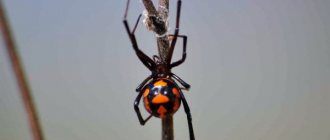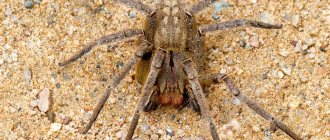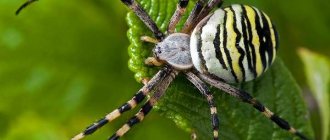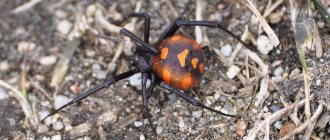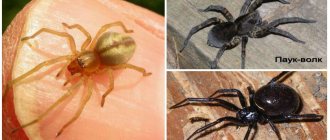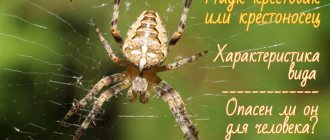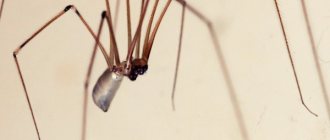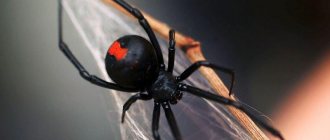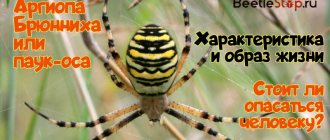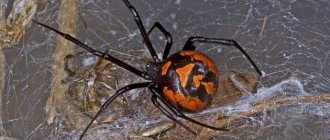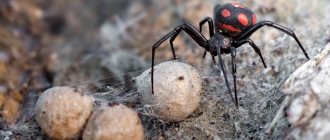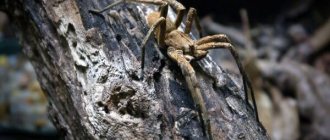The Argiope bruennichi or wasp spider is a common spider that stands out for its bright colors. Arthropods differ from other spiders in their way of life. Such factors have led to the fact that this animal is increasingly kept as an exotic pet.
The spider received this name in honor of the Danish zoologist Morten Trane Brünnich.
Spider wasp or Agryope Brunnich, appearance
What does the Argiope bruennicha spider look like?
Argiope spider.
Skilled braiders
Like all web spiders, Argiope Brünnich prepares traps stretched between blades of grass and low branches of bushes. The networks of this species of arachnids are circular, in the center they have a zigzag-like pattern, characteristic of the weaving of all brothers in the genus Argiope and called stabilimentum. Despite the small size of the hunter, his traps are very durable, capable of holding a grasshopper, which is 2-3 times larger than the predator. Argiope Brünnich spends only an hour creating nets that are woven at sunset, in the approaching twilight.
Description of the spider
Name: Argiope bruennichi Lat.:
Argiope bruennichiClass: Arachnida - Arachnida Order: Spiders - Araneae Family: Orb-weaving spiders - Araneidae
| Habitats: | edges, forests and lawns |
| Dangerous for: | small insects |
| Attitude towards people: | harmless, do not harm |
This type of spider is difficult to confuse with others. The bright color of the abdomen, consisting of alternating transverse stripes of black and yellow, is very similar to the color of a wasp. At the same time, females and males of this species differ markedly from each other.
Thanks to the characteristic stripes, Agryope began to be called the wasp spider, zebra spider or tiger spider.
Appearance of the male
Female individuals have a bright pattern with clear lines on the abdomen, and the cephalothorax is densely covered with silver-colored villi. The length of their body can reach 2-3 cm. The walking legs are painted beige and decorated with pronounced black rings.
Appearance of the female
Agriopa males are significantly smaller than females. Their body reaches no more than 5 mm in length. The color of the abdomen is in light gray and beige shades. The rings on the legs are faint, blurred and gray or brown. On the outermost segments of the tentacles are the male genital organs - cymbiums.
Appearance
The body is divided into the abdomen and cephalothorax, which are connected to each other by a thin stalk. The cephalothorax is covered with a durable chitinous layer that protects it from mechanical damage.
Inside it is the brain and stomach. 4 pairs of walking legs, a pair of pedipalps and a pair of chelicerae extend from it. The limbs are thin and long. They help the spider deftly move along the shaky threads of the web. The pedipalps are used for touching and grasping prey.
The spider has 8 eyes, which are located on the front of the cephalothorax . One pair is especially large, located on top. Others are smaller, located in front and to the side of the largest pair.
There are also chelicerae that end in sharp curved fangs. Venom glands approach the fangs. On the last pair of legs there are special appendages, which consist of a layer of bristles.
They are used for weaving multilayer networks with complex patterns. With their help, the spider arranges its webs into the patterns it needs. This is a characteristic feature of all orb weavers. At the back of the lower part of the abdomen there are arachnoid appendages.
The tiger spider is famous for its strong sexual dimorphism. The body of females reaches 1.5 cm in length, males rarely grow more than 5 mm. The female's paw span can reach 4 cm.
Females boast a brighter color, which is designed to indicate the poisonousness of the spider and scare away predators. The abdomen is black with yellow stripes, sometimes white stripes can be seen on it. The fourth dark stripe from the cephalothorax has two wavy bends.
The coloring resembles that of a wasp. The abdomen is round in shape and has 4 concave sections. The cephalothorax is covered with gray hairs that shimmer in the light. The legs are long, black with yellow stripes. The pedipalps are long and light colored.
Males have an elongated long abdomen. The body is light brown in color. On the back, against a light background, two parallel dark stripes are visible.
On the long legs you can see sparse black bristles. At the ends of the pedipalps there are small thickenings - bulbs. The male does not at all resemble a wasp in appearance, so its species affiliation is more difficult to determine at first glance.
Features of reproduction
A pair of Argiope spiders.
Sexual maturity of the female occurs immediately after molting. Males try to mate with the female as quickly as possible, before her chelicerae become hard enough. During the mating process, males very often lose one of the bulbs, which makes it weaker and more vulnerable. After mating is completed, the large and aggressive female most often tries to attack the male and eat him.
After fertilization, the female begins to prepare a protective cocoon in which she lays mature eggs. One brood of the Agriopa spider can include up to 200-400 cubs. The new generation is born around the end of August - beginning of September.
Origin of the species and description
Photo: Argiope Brünnich
Argiope brunnich belongs to the arachnid arthropods, is a representative of the order of spiders, the family of orb-weaving spiders, the genus Argiope, the species of Argiope brunnich.
The spider received the name Argiope in honor of the ancient Greek nymph. About three hundred years ago, it was customary to give insects the names of ancient Greek divine creatures. Brunnich is the name of a researcher, a zoologist originally from Denmark, who wrote a large encyclopedia on insectology in 1700.
Video: Argiope Brünnich
The exact time of origin and stages of evolution of this species of arthropod is quite difficult to determine. This is due to the fact that the protective chitinous layer is destroyed quite quickly. The few remains of various parts of the body of the ancient ancestors of arachnids were most often preserved in amber or resin. It was these findings that allowed scientists and researchers to suggest that the first arachnids appeared approximately 280 - 320 million years ago.
The oldest discovery of an arthropod was discovered in the territory of the modern People's Republic of China. Judging by the body parts isolated from amber, the arthropods of that period were small in size, not exceeding five to six millimeters. Characteristically, they had a long tail, which disappeared during the process of evolution. The tail was used to make the so-called spider web. The ancient ancestors of arthropods did not know how to weave webs; they simply involuntarily secreted dense sticky threads, which they used to weave their shelters and protect cocoons.
Another characteristic feature of ancient spiders was the almost separate cephalothorax and abdomen. Zoologists suggest that the place where spiders appeared is Gondwana. With the advent of Pangea, insects began to spread almost at lightning speed throughout the entire landmass. With the onset of ice ages, insect habitats declined significantly.
Lifestyle of the Agryope spider
In the wild, representatives of this species can form small colonies of up to 20 individuals. The Agriopa spider is most attracted to open, well-lit areas. This type of arthropod can be found in clearings, lawns, forest edges and along roads.
How the spider Agriope weaves a web
Like other spiders of the orb-weaving family, Agryope weaves a very beautiful pattern on its web. In the center of its web, the wasp spider has a zigzag pattern of dense threads, which is called the stabilimentum. The stabilimentum has two purposes:
- This multi-layered pattern perfectly reflects the sun's rays and can be used to attract insects.
- Sensing the approach of danger, the spider Agryope begins to shake its webs. Because of this, the rays reflected by the web merge into one bright spot, which scares off a potential enemy.
Spider wasp in its web.
It is worth noting that the wasp spider weaves its webs exclusively at dusk. It takes Agriopa about an hour to weave a new circular web with a characteristic pattern.
After the web is ready, the female positions herself in the center and spreads her paws wide. At the same time, the first two and last two pairs of limbs are kept closer to each other, which is why the outline of the spider resembles the letter “X”.
Diet of the wasp spider
Spiders of this species are not particularly picky about food and their menu may include:
- grasshoppers;
- flies;
- mosquitoes;
- crickets;
- bugs;
- locusts
As soon as an insect gets caught in Agriopa’s net, she quickly rushes towards her, injects her paralyzing poison into the victim’s body and entangles him in a web. After some time, all the internal organs of the caught insect, under the influence of enzymes, turn into liquid, which the spider safely sucks out.
Natural enemies of the Agriopa spider
Due to its bright coloring, the wasp spider may not be afraid of most bird species, since the contrasting stripes on the abdomen scare away these feathered hunters. Agryope also rarely becomes a victim of predatory insects and other arachnids.
Argiope spider.
The most dangerous enemies of spiders of this species are:
- rodents;
- lizards;
- frogs;
- wasps;
- bees.
Nutrition
The tiger spider weaves large trapping nets that have a complex beautiful pattern and small cells. The spider waits for its prey in their very center.
In this case, the first two pairs of legs are directed forward, and the third and fourth pairs are directed back. Thus, visually, the spider’s body takes the shape of the letter X. The spider does not have very good eyesight, but it perfectly feels the vibrations of the air and the web.
Argiopes mainly feed:
- grasshoppers;
- crickets;
- locusts;
- mosquitoes;
- flies.
But often other insects get caught in the net, which the spider is not averse to snacking on. As soon as the prey falls into the trap, the spider senses the vibration and rushes towards the victim.
The spider attacks the insect, bites and injects poison under the chitinous layer. For some time the predator watches the prey from a distance. As soon as the insect stops moving, the argiope wraps the victim in a web.
The spider bites through the threads holding the prey. He lowers the victim to the ground to feast on it in a secluded place or hide it in reserve. One Argiope prey can last for a week.
Argiopes, like other spiders, have external digestion. The arthropod's venom promotes the decomposition of the insect's entrails. Some time after the bite, the spider returns to its prey. It sucks out all the insides of the insect, leaving only the chitinous layer.
Sometimes the argiope itself becomes a victim if a wasp or too large beetle gets caught in its net. The spider tries to escape, but sometimes it can be caught by its own victim or pierced by the poisonous sting of a wasp.
How dangerous is the Agriope spider for humans?
The venom of the Agriopa spider is not highly toxic. Animals use it to cause paralysis in small insects caught in their nets. Based on experiments conducted by scientists, it was proven that the entire supply of poison of one female Agriopa is not enough to kill an adult black cockroach.
The Agriope spider is not prone to aggression and, sensing the approach of danger, it leaves its web and runs away. Agriope can attack a person only if she is driven into a corner or when trying to pick up an arthropod.
The bite of a wasp spider can be dangerous for small children or if a person is prone to allergic reactions to insect bites. For a healthy adult, an Agriope bite is not fatal, but can lead to the following symptoms:
- acute pain at the site of the bite;
- swelling and redness of the skin;
- severe itching.
Are you afraid of spiders?TerribleNo
If the reaction to the bite is more severe, you should immediately seek help. The help of a specialist is definitely needed for symptoms such as:
- severe increase in body temperature;
- dizziness;
- nausea;
- the appearance of severe swelling.
Danger to humans
We immediately warn those who are interested in extreme sports - if you touch the web of an argiope with your hand, it will react and will definitely bite. Argiope's bite is painful and can be compared to a wasp or bee sting. This spider has very powerful jaws; it can bite quite hard.
In addition, we must not forget about its poison. Many people are interested in the question: is argiope poisonous or not ? Of course, it is poisonous; it is with this toxin that they provide themselves with food by killing their victims. Has a paralyzing effect on invertebrates and vertebrates.
The second question is that the poison is not dangerous for humans and large animals. Spider venom contains argiopine, argiopinin, pseudoargiopinin, but in small doses that do not pose any particular harm to humans.
The consequences of this bite are not fatal, but can cause a number of significant inconveniences and troubles. Most people experience redness and slight swelling near the site of the bite, which goes away within a couple of hours.
But it happens that these signs disappear only after a day, and the bite can be very itchy. But if you have a weakened immune system, have an allergic reaction, or have a child with you who has been bitten by a spider, then the consequences can be unpleasant:
- The bite site swells noticeably;
- Body temperature rises, sometimes quite significantly, up to 40-41 degrees;
- Nausea and dizziness begin.
There is only one way out - immediately see a doctor. No “it will go away later” or “I’ll heal myself.” Don't risk your life. And as first aid, cauterize the bite site and give an antihistamine. And drink plenty of water.
Habitat of the Agryope Brünnich spider
This type of spider prefers steppe and desert zones. Their habitat covers almost the entire Palearctic region. Agryope Brünnich can be found in the following regions:
- Southern and Central Europe;
- North Africa;
- Asia Minor and Central Asia;
- Far East;
- Japanese islands.
In Russia, the wasp spider is found mainly in the southern part of the country, but every year representatives of this species are increasingly found in more northern regions. At the moment, you can encounter Agriopa in Russia in the following areas:
- Chelyabinskaya;
- Lipetskaya;
- Orlovskaya;
- Kaluzhskaya;
- Saratovskaya;
- Orenburgskaya;
- Samara;
- Moscow;
- Bryansk;
- Voronezh;
- Tambovskaya;
- Penza;
- Ulyanovskaya;
- Novgorodskaya;
- Nizhny Novgorod.
Enemies of the striped wasp spider in nature
It’s not for nothing that Argiope is painted with black and yellow stripes, like a wasp - now birds don’t eat it. He has peaceful relations with his relatives - there are no wars either for territory or for the female (only in childhood, if they are very hungry, spiders eat each other). It is not attracted to insectivorous plants, since it does not wander through the forest and is not tempted by sweet smells. It is protected from insects (ants, scolopendras, dragonflies) by a sticky web.
Lizards, frogs and rodents pose a danger, but even for them the spider has an ace up its sleeve (that is, in a yellow and black stocking). In case of danger, Argiope shakes the web, and the reflected light confuses the enemy. Plan B is to fall into the grass and get lost. Wasps and bees caught in webs are also dangerous. Although they look similar in stripes, their venom is fatal to a spider. In this case, the one who can pierce the enemy first will win.
Interesting facts about the spider Agryope
The wasp spider attracts the attention of many people not only because of its unusual and bright color, but also due to several interesting features:
- After hatching from the egg, the young generation disperses by flying on their own webs. Like “flying carpets,” their networks pick up air currents and carry them over vast distances. According to scientists, it is precisely such flights that are the reason for the colonization of more northern regions by this species.
- Agyriope thrives in captivity and this makes them very easy to keep in terrariums. In this case, it is very important to place only one spider inside, since these creatures will not share their living space with neighbors. When it comes to feeding, the wasp spider is also unpretentious. It is enough to leave him special insects from the pet store at least every other day.
The benefits and harms of the spider
As we have already said, this spider does almost no harm to humans. If you don't offend him yourself. It just litters open spaces with its web, slightly interfering with a carefree walk. But this is not a harm, just a minor inconvenience.
But it has great benefits. It can catch up to 400 harmful insects in its nets per day. Therefore, do not rush to destroy them if you see them in a meadow or forest edge. In the forest, in the garden or in the vegetable garden, these tireless orb weavers weave their nets and catch springtails, leaf rollers, bugs, aphids, caterpillars, mosquitoes, flies and other harmful insects in them.
Spiders are voracious; in a day they eat as much as their own weight. So consider how much benefit this ecological insect trap can bring over the summer. In addition, according to ancient Eastern philosophy, the spider brings good luck.
Argiope bites are painful, but not capable of causing significant harm to humans.
Login to the site
This small spider has many names - spiny spider, spiny orb spider, horned spider, etc. The thing is that along the edges of its wide abdomen there are 6 spines (“horns”), which give the spider a rather menacing appearance.
Spiny orb-weaver spider, Horned Spider)
These spiders are common in tropical and subtropical zones. They can be found in the southern part of the USA (from California to Florida), in Central America (Jamaica, Cuba, Dominican Republic), South America, the Bahamas, as well as in Australia and the Philippines. As we can see, their habitat is quite extensive. They weave their nets in bushes and trees near swamps and streams.
The appearance of the spider is very unusual. The spider is wider than it is long. So the length of the female’s body is 5-9 mm, and the width is 10-13 mm. These spiders have pronounced sexual dimorphism, i.e. females are several times larger than males. Their body length is only 2-3 mm. Unlike many species of spiders, the horned spider has short legs.
Spikes along the edge of the abdomen
Male spiny spider
Female spiny spider
Spiny spiders attract attention not only with their unusual body proportions, but also with the variegated coloring of their abdomen. It can be white, bright yellow, red, black, etc.
Their colors depend on the species and habitat. The legs, shield and lower part of the abdomen are black with white spots under the belly. In males, the lower part of the abdomen is gray with white spots.
Yellow color
White color
And even this color
On the outer part of the abdomen there is a peculiar pattern of black dots, which are arranged in 4 rows. All of them have a mirror arrangement according to the vertical axis of the body. Does this drawing remind you of anything?
Like Jackson's mask?
There are six spines along the edge of the abdomen. They are also called "backbones". They can be black or red. In males they are not so pronounced, and their number may be less - 4-5 spines. They give the spider a more intimidating appearance, which helps scare away potential enemies. Otherwise, they can become quite a tasty snack. In addition, hard thorns make it difficult to swallow their owner.
They feed on small insects that they catch in their nets. The spider trap is a fairly strong net, reaching a diameter of 30 centimeters. They have an almost perfect circle shape, in the middle of which there is a thin network. It serves as a base for the spider. Only females weave webs. The males are located nearby, hanging on several threads.
Spiny spider webs
Central part of the web
It is interesting that if these spiders live in a small group, then the caught prey is divided among everyone, regardless of whose net it fell into. But most often they live alone.
As for the reproductive process, scientists still do not understand whether these spiders are polygamous or monogamous (the female mates with one male or several). In nature, sometimes you can see females with up to 3 hanging males around the web.
The male notifies the female of his presence by making peculiar taps on the network. After fertilization, he dies 6-7 days later, unless he becomes the female’s lunch immediately after mating.
Horned Spider in Macro (Gasteracantha cancriformis) from iChip on Vimeo.
The female begins to weave a cocoon on the inside of the leaf not far from the web, into which she then lays from 100 to 260 eggs. After this, she also dies. Thus, the life expectancy of these spiders is short: for males - up to 3 months, for females - up to a year. Spiders are born in winter. They grow up in 2-5 weeks and scatter in different directions.
The bite of this spider can be painful, but not dangerous. There may be slight redness and swelling at the site of the bite.
Spiny orb spider or “horned spider” (lat. Gasteracantha cancriformis)
Birds of Siberia
The territory of Siberia has traditionally been represented by two geographical parts - Western Siberia and Eastern Siberia. The region is distinguished by a large number of feathered predators, small and nimble birds, as well as long-legged beauties, including the Far Eastern stork.
Stork
A fairly large bird with long legs, a high neck and a long elongated beak. White and black storks live in Siberia. The average weight of a white stork is 3.5-4.0 kg. The legs and beak of the bird are red in color. The adult female differs from the male in smaller stature. One nest is used by such monogamous birds for several years. Storks begin to breed at the age of three.
Golden eagle
A falcon-like bird from the hawk family has long and rather narrow wings, as well as a slightly rounded tip of the tail. The golden eagle is distinguished by strong paws with fairly large claws. In the occipital region of the head there are small and pointed feathers. The average length of a bird varies between 80-95 cm, with a wing size of up to 60-72 cm and a weight of no more than 6.5 kg. Females are larger in size.
Thrush
A representative of the Thrush family and the Passerine order, it is small in size, ranging from 20-25 cm. The bird moves along the ground in small jumps. The thrush's nest is very large and strong, made using clay and earth. Northern varieties of thrush go to the southern territories for the winter. The male thrush has black plumage, while females have dark brown feathers with a light throat and a rufous chest.
Bustard
The rather large bird is quite rare in Russia and is on the verge of extinction today. The bustard resembles an ostrich in appearance, is distinguished by strong legs with no feathers, has a high neck and a head with a small beak. The color scheme is represented by red and white tones. The average body length of adult males reaches 100 cm, with a weight of about 18 kg.
Lark
The bird is a representative of the order Passeriformes and the Larks family. Such birds settle in open space, preferring fields and steppes, forest clearings and alpine meadows. Larks are distinguished by rather long and wide wings, small legs with a large posterior nail. The color of the plumage directly depends on the species characteristics of the bird.
Finch
The songbird from the Finaceae family prefers light deciduous and mixed forests and is found in groves and oak forests, gardens and park areas. With the onset of winter, the inhabitants of the territory of Siberia fly to warmer regions. The finch has a thin, conical beak. The plumage of males is predominantly black-brown with white stripes. There are greyish-blue feathers on the top of the head.
Kobchik
A representative of the Falcon family is common in taiga areas. This rare species is distinguished by its relatively small size. Females are usually larger than males. The falcon has a small and insufficiently strong beak, characterized by relatively small and rather weak fingers with small claws. The plumage of this rare bird is not too rigid, but more loose.
Lun
A bird from the Accipitridae family is a rare species, whose representatives have a body length in the range of 49-60 cm, with a wingspan of no more than 110-140 cm. The average weight of an adult bird varies between 500-750 grams. The western species has gray, white and brownish plumage. Flying birds move at low altitudes. Nests are located in wetlands, with the presence of reeds and reeds.
Osprey
Osprey is a large representative of the Falconiformes order and the Skopinae family, distinguished by black and white wing plumage. The bird is listed in the Red Book. A distinctive feature of the feathered predator is the presence of sharp tubercles on its fingers, which are used when grasping fish. The upper part of the body is black, and there are white feathers on the head. The wings are long, with noticeably pointed ends.
Habitat
The spider with yellow and black stripes is predisposed to mild, warm climates and does not tolerate high humidity and cold. This explains the choice of its habitat:
- Africa;
- Asia;
- Indonesia;
- Korea;
- China;
- European countries (central, southern);
- South and North (up to Canada) America.
In Russia and the CIS countries, Argiope Brünnich lives in warm regions. The yellow-bellied spider loves to soak up the sun. He feels comfortable on open lawns, forest clearings, and roadsides.
The animal hangs its trap nets close to the surface of the earth, at a height of 30-40 centimeters. To do this, he chooses neglected places where he will not be disturbed by either animals or people.
On a note. Wasp spiders live in groups: where there is one, there will definitely be another two to three dozen individuals nearby.
The black and yellow spider has the ability to move through the air over long distances. The lack of wings is compensated for by a self-woven long and strong web. Blown away by the wind, she can deliver her “weaver” to quite remote places. It is not surprising that heat-loving arthropods can also live in cold northern latitudes.
When do Argiopes bite?
Although the spider wasp is extremely poisonous, its harm to humans is minimal. People are scary for agriopes, since arthropods see humans as a danger. And human skin is too thick for such spiders and they cannot bite through it. Most likely, upon meeting, the predator will run away or pretend that it died a long time ago.
But if you touch an animal with your bare hands, it will definitely bite, which will cause noticeable pain.
Is the bite poisonous?
The spider bite is poisonous! Therefore, the area affected by the predator will turn red and begin to itch, and poison that gets on the skin can cause a serious allergic reaction. So it’s better to stay away from the beautiful spider and under no circumstances interfere with his life in peace.
Note! If you happen to encounter such a predator in your own garden or dacha, it is better to move it away, using a stick or other object, making sure that it does not have the opportunity to attack.
First aid for a bite
If a spider does bite you, there is no need to panic, but inaction can also cause harm.
Recommendations for action in case of a bite:
- The first thing you need to do is disinfect the bite site. Wipe the affected area with an alcohol-soaked cotton swab. If there is no alcohol, you can use a solution with soda or wash the desired area well with laundry soap.
- You can make a compress and apply something cold to the bite site, ideally hold a piece of ice on the damaged area.
- If possible, it is better to immediately give the victim an antihistamine to swallow.
- The person bitten should drink plenty of water.
If a patient develops symptoms of an allergic reaction, you should immediately call an ambulance.
How to get rid of it?
If such a defect appears, you should consult a dermatologist. He will conduct the necessary research, prescribe treatment or select a safe way to eliminate unwanted pigmentation.
Products based on salicylic alcohol, citric acid, and hydrogen peroxide have a good whitening effect. You can buy them at the pharmacy or prepare them yourself
It is important to strictly follow the dosage to avoid burns. Beauty salons offer procedures to get rid of stains:
- cryotherapy (exposure to liquid nitrogen);
- laser removal (removal of the top layer of skin with a light beam);
- mesotherapy (administration of drugs with a whitening effect);
- peeling (partial removal of the epidermis with chemicals).
Not all spots on the back are harmless. Sometimes unusual pigmentation is one of the symptoms of a dangerous disease. You should not try to deal with it on your own; if it appears, you should consult a dermatologist.
Keeping at home
For arachnid lovers, information about the rules for keeping a spider such as Argiope bruennicha at home will be useful.
For the optimal home for Argiope bruennichi, you will need to get a terrarium large enough for the wasp spider to have room to spread out. The optimal size would be 20x30 centimeters and a height of about 20 centimeters.
It is better to choose a mesh lid for such a terrarium so that enough air can freely flow inside.
Inside the terrarium, dry grape branches should be placed at different angles and of different sizes so that it is convenient for the spider to engage in its usual web weaving.
He will arrange secluded places in the corners of the terrarium, where he will hide excess prey. It is recommended to maintain room temperature inside the terrarium and ensure sufficient humidity.
Important! It is recommended to spray the entire terrarium with water from a spray bottle only in the summer, when the outside temperature exceeds 30 degrees. Excessive humidity can promote the development of mold and mildew, which will lead to the death of the spider.
Bitten by a spider - what to do before the ambulance arrives
These representatives of the order of arthropods can attack adults and children, both in the house and in open areas.
The bites of many spiders will not cause any significant harm to a person - slight redness on the skin will disappear within a day. But after an attack by a karakurt or hermit, a severe allergic reaction, swelling of the larynx and respiratory arrest can develop. It depends on the type of arthropod what to do if bitten by a spider, what first aid to provide to a person.
Even if there are no symptoms, the victim should be quickly taken to the nearest hospital facility.
Spiders attack humans not only in open areas, but also in residential areas
The effect of poison on the human body
The damage caused to human health depends on the qualitative and quantitative characteristics of the poison released by spiders during bites. The larger the specimen, the greater the danger it poses to humans.
Small arthropods are often simply not able to bite through the skin or produce the amount of poison that can harm an adult or baby. But such a statement is true only for representatives of one species. Tarantulas are larger than karakurts, but their bites do not cause significant harm to humans.
But after an attack by a recluse spider, a fatal outcome is quite possible. Depending on the effect of toxic compounds, scientists distinguish two types of poison:
- neurotoxic, affecting the central and peripheral nervous system;
- hemolytic, destroying red blood cells after penetration into the bloodstream.
Karakurt and brown recluse spiders are the most dangerous arthropod species living in our country. And tourists and experienced travelers can become victims of attacks by other arthropods in any corner of the planet.
Symptoms
The bites of many, even extremely dangerous spiders, are completely painless. A person mistakes a slight swelling or redness on the skin for a scratch and does not take any action.
And the symptoms of general intoxication of the body that developed within a few hours are very similar to the signs of any bacterial or viral infection.
Such a clinical picture of jointed bites can mislead not only the victim, but also diagnosticians.
: Almost all spiders are predators. Having lured the victim with a shiny web, they injected it with a paralyzing poison. And when attacking a person, spiders use this method only to protect their own life.
There are several indirect signs that help a person distinguish a scratch or small wound from a spider bite. After an arthropod attack, the following symptoms occur:
- the bite area gradually swells, and in some cases a pink or red erythema similar to a thin ring forms;
- after a few minutes or hours, pain occurs in the limbs, tremors or convulsions may occur;
- swelling of various localizations develops: at the site of the bite, the upper half of the body or the face;
- heart rate increases, lack of air is felt;
- Blood pressure may rise and then drop to life-threatening levels.
If the victim is predisposed to developing allergic reactions, then large or small red spots form on the skin. They are very itchy and quickly spread throughout the body. Such symptoms of a spider bite can vary significantly depending on the species of the spider.
After a spider bite, the skin turns red and begins to swell quickly
Recluse spider bite
Despite the fact that this type of arthropod is not large in size, its bite is deadly even for a strong, healthy man. The recluse spider pierces the skin in such a way that a person does not experience the slightest discomfort. The poison enters the systemic bloodstream and gradually spreads throughout the body. What does a spider bite look like:
- the bite site swells;
- the size of the swelling rapidly increases;
- large ulcers form.
If this area of skin is not treated with antiseptic agents, then after a while the soft tissues begin to ulcerate and die. The clinical picture of intoxication is similar to signs of a respiratory infection:
- aches in bones and joints;
- rise in temperature;
- decreased functional activity of the cardiovascular system.
The victim's urinary organs are disrupted and their metabolism slows down significantly. The heart rate decreases and difficulty breathing occurs. If a person is not given medical assistance at this stage of intoxication, he may die.
Karakurt spider - Latrodectus tredecimguttatus
photo of karakurt
This is not a big black spider at all. The body of the female (10-20 mm) is completely black, which is why she is also called a black widow, the body of the male (4-7 mm) is also black, but with bright red spots on the abdomen (usually 13 spots). The karakurt spider lives in Central Asia, Iran, Afghanistan, on the shores of the Mediterranean Sea, North Africa, Southern Europe, Kazakhstan, southern Russia and Ukraine. They prefer the slopes of ravines, virgin wormwood, wastelands, and the banks of irrigation ditches. Karakurts inhabit abandoned rodent burrows and ventilation systems, entwining the entrance with cobwebs. In such dens, females and males mate at the end of summer. The female lays her eggs in a cocoon of cobwebs and hangs it in her den. In spring, spiderlings emerge from cocoons. Karakurts feed on small insects. Their venom is toxic to large animals and people. There is a burning sensation and swelling at the site of the bite. After 10-15 minutes, the poison spreads throughout the body and the person experiences pain in the chest and abdominal area. Dizziness, nausea, sweating, rapid heartbeat, and delirium also occur. And if medical assistance is not provided in time, death is possible (in most cases). Karakurt bites through the skin only 0.5 mm, so it is recommended to cauterize the bite site with a lit match within 2 minutes after the bite.
